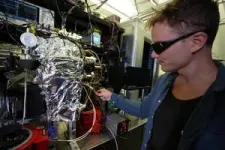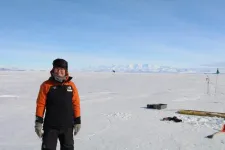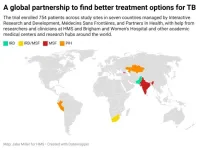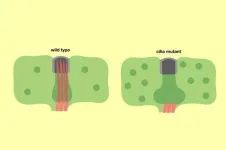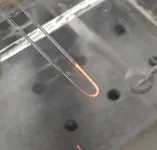(Press-News.org) Scientists at the National Institute of Standards and Technology (NIST) have created a new thermometer using atoms boosted to such high energy levels that they are a thousand times larger than normal. By monitoring how these giant “Rydberg” atoms interact with heat in their environment, researchers can measure temperature with remarkable accuracy. The thermometer’s sensitivity could improve temperature measurements in fields ranging from quantum research to industrial manufacturing.
Unlike traditional thermometers, a Rydberg thermometer doesn’t need to be first adjusted or calibrated at the factory because it relies inherently on the basic principles of quantum physics. These fundamental quantum principles yield precise measurements that are also directly traceable to international standards.
“We’re essentially creating a thermometer that can provide accurate temperature readings without the usual calibrations that current thermometers require,” said NIST postdoctoral researcher Noah Schlossberger.
Revolutionizing Temperature Measurement
The research, published in Physical Review Research, is the first successful temperature measurement using Rydberg atoms. To create this thermometer, researchers filled a vacuum chamber with a gas of rubidium atoms and used lasers and magnetic fields to trap and cool them to nearly absolute zero, around 0.5 millikelvin (thousandths of a degree). This means the atoms were essentially not moving. Using lasers, they then boosted the atoms’ outermost electrons to very high orbits, making the atoms approximately 1,000 times larger than ordinary rubidium atoms.
In Rydberg atoms, the outermost electron is far away from the core of the atom, making it more responsive to electric fields and other influences. This includes blackbody radiation, the heat emitted by surrounding objects. Blackbody radiation can cause electrons in Rydberg atoms to jump to even higher orbits. Rising temperatures increase the amount of ambient blackbody radiation and the rate of this process. Thus, researchers can measure temperature by tracking these energy jumps over time.
This approach enabled the detection of even the most minor temperature changes. While there are other types of quantum thermometers, Rydberg thermometers can measure the temperature of their environment from about 0 to 100 degrees Celsius without needing to touch the object being measured.
This breakthrough not only paves the way for a new class of thermometers but is particularly significant for atomic clocks, because blackbody radiation can reduce their accuracy.
“Atomic clocks are exceptionally sensitive to temperature changes, which can cause small errors in their measurements,” said NIST research scientist Chris Holloway. “We’re hopeful this new technology could help make our atomic clocks even more accurate.”
Beyond precision science, the new thermometer could have wide-ranging applications in challenging environments from spacecraft to advanced manufacturing plants, where sensitive temperature readings are essential.
With this development, NIST continues to push the boundaries of science and technology.
“This method opens a door to a world where temperature measurements are as reliable as the fundamental constants of nature,” Holloway added. “It’s an exciting step forward for quantum sensing technology.”
END
New atom-based thermometer measures temperature more accurately
2025-01-29
ELSE PRESS RELEASES FROM THIS DATE:
COVID lockdowns disrupted a crucial social skill among preschoolers, trailblazing study finds
2025-01-29
Lockdowns. Social distancing. Shuttered schools and businesses. The COVID-19 pandemic and its sweeping disruptions set off a stampede of “what it’s doing to us” research, focused largely on schoolchildren. How were students’ academics affected? Their mental health? Their social development?
Left unexamined was whether the pandemic impacted the social cognition of preschool children — kids younger than 6 — whose social norms were upended by day care closures and families sheltered at home.
That changed when a UC Merced ...
Otago scientists discover Antarctic fast ice secrets
2025-01-29
University of Otago – Ōtākou Whakaihu Waka scientists have successfully analysed more than 30 years of vital data on the thickness of landfast sea ice in Antarctica’s McMurdo Sound, which will prove useful to measure future impacts of climate change.
The study, published in the Journal of Geophysical Research: Oceans, set out to discover what key influences determine the thickness of landfast sea-ice, known as fast ice, using data from 1986 to 2022.
Fast ice is frozen ocean water that is attached to shorelines and persists for at least 15 days. It provides vital habitats for penguins and seals, as well as fish, krill and algae underneath the ice.
Scientists ...
Study finds three new safe, effective ways to treat drug-resistant tuberculosis
2025-01-29
Tuberculosis remains one of the top infectious disease killers worldwide, a challenge amplified by drug-resistant forms of the disease. Now, in a major step forward, an international clinical trial has found three new safe and effective drug regimens for tuberculosis that is resistant to rifampin, the most effective of the first-line antibiotics used to treat TB.
The research, published Jan. 30 in the New England Journal of Medicine, was led by researchers at Harvard Medical School and other members of the endTB project, ...
A weekly injection could replace painful daily treatment for rare fat disorder
2025-01-29
Rutgers Health researchers have found that a weekly injection of diabetes medication could replace painful daily hormone shots for people with a rare genetic form of lipodystrophy that leaves patients with almost zero fat tissue, according to a study in The New England Journal of Medicine.
Congenital generalized lipodystrophy (CGL), which affects only a few thousand people worldwide, results in severe metabolic disease, diabetes, insulin resistance and reduced life expectancy. With no fat tissue for proper storage, fat accumulates in organs ...
More Americans than ever are confident about providing lifesaving CPR, new survey suggests
2025-01-29
DALLAS, January 29, 2025 — When someone’s heart stops pumping, early CPR can save their life.[1] New survey research from the American Heart Association reveals more Americans are prepared to provide that lifesaving rhythm for their friends, family and community.
The newly released data, conducted by Decision Analyst on behalf of the American Heart Association, indicates more U.S. adults now say they feel ready to handle and respond to a cardiac arrest[2]. When Damar Hamlin collapsed on the field during Monday Night Football in January ...
Uber, Lyft or transit? The answer appears to align with how people value their time
2025-01-29
Research led by the University of Michigan arrived at a surprisingly unsurprising result while assessing the sustainability gap between public transit and services like Uber and Lyft, formally known as transport network companies or TNCs.
With data collected by the city of Chicago, the researchers studied people's use of TNCs over transit, allowing the team to put a value on the time riders saved with their choices. The median value of that number, about $34 per hour, was virtually identical to the Chicago region’s median hourly wage.
"I was a bit surprised that our median ...
Researchers uncover key insights into how the body protects against neuron damage
2025-01-29
Neurons may get all the glory, but they would be nothing without glial cells. While brain cells do the heavy lifting in the nervous system, it’s the glia that provide nutrients, clean up waste, and protect neurons from harm.
Now, scientists have discovered a new mechanism by which these crucial supporting players detect and respond to neuron damage. Published in Nature Communications, the study describes how two key proteins allow glial cells to actively monitor the hair-like cilia that extend out of nematode dendrites, so that the glial cells can respond ...
Diagnostic stewardship optimizes detection of appendicitis
2025-01-29
Abdominal pain is among the most common reasons children are taken to the emergency department.
A small proportion of them usually have appendicitis, and timely detection is essential.
To do so, clinicians often rely on imaging, such as ultrasound or CT scans.
Although delayed diagnosis of appendicitis in children can be life threatening, overtesting is wasteful and can even cause harm.
Now in a study, published in Academic Emergency Medicine, University of Michigan researchers found that emergency departments vary widely in how they balance the ...
Optical fiber sensor provides simple and sensitive detection of arsenic in drinking water
2025-01-29
WASHINGTON — Researchers have developed a new optical sensor that provides a simple way to achieve real-time detection of extremely low levels of arsenic in water. The technology could enable household testing for arsenic, empowering individuals to monitor their own water quality.
Arsenic contamination is a serious environmental and public health challenge affecting millions of people around the world. This contamination occurs when natural geological processes release arsenic from rocks and soil into groundwater ...
Oceanic plate between Arabian and Eurasian continental plates is breaking away
2025-01-29
An international research team led by the University of Göttingen has investigated the influence of the forces exerted by the Zagros Mountains in the Kurdistan region of Iraq on how much the surface of the Earth has bent over the last 20 million years. Their research revealed that in the present day, deep below the Earth’s surface, the Neotethys oceanic plate – the ocean floor that used to be between the Arabian and Eurasian continents – is breaking off horizontally, with a tear progressively ...

